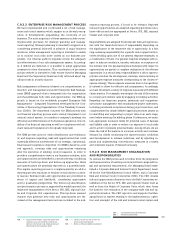Siemens 2012 Annual Report Download - page 207
Download and view the complete annual report
Please find page 207 of the 2012 Siemens annual report below. You can navigate through the pages in the report by either clicking on the pages listed below, or by using the keyword search tool below to find specific information within the annual report.
135 D. Consolidated Financial Statements
239 E. Additional Information
130 C. Siemens AG (Discussion on basis of
German Commercial Code)
134 C. Notes and forward-looking statements
129 C. Compensation Report, Corporate Governance
statement pursuant to Section a of the
German Commercial Code, Takeover-relevant
information and explanatory report
...
We have implemented and coordinated a set of risk manage-
ment and control systems which support us in the early recog-
nition of developments jeopardizing the continuity of our
business. The most important of these systems include our en-
terprise-wide processes for strategic planning and manage-
ment reporting. Strategic planning is intended to support us in
considering potential risks well in advance of major business
decisions, while management reporting is intended to enable
us to monitor such risks more closely as our business pro-
gresses. Our internal auditors regularly review the adequacy
and effectiveness of our risk management system. According-
ly, if deficits are detected, it is possible to adopt appropriate
measures for their elimination. This coordination of processes
and procedures is intended to help ensure that the Managing
Board and the Supervisory Board are fully informed about sig-
nificant risks in a timely manner.
Risk management at Siemens is based on a comprehensive, in-
teractive and management-oriented Enterprise Risk Manage-
ment (ERM) approach that is integrated into the organization
and that addresses both risks and opportunities. Our ERM ap-
proach is based on the worldwide accepted Enterprise Risk
Management – Integrated Framework developed by the Com-
mittee of Sponsoring Organizations of the Treadway Commis-
sion (COSO). The framework connects the ERM process with
our financial reporting process and is closely integrated in our
internal control system. It considers a company ’s strategy, the
efficiency and effectiveness of its business operations, the reli-
ability of its financial reporting as well as compliance with rel-
evant laws and regulations to be equally important.
The ERM process aims for early identification and evaluation
of, and response regarding, risks and opportunities that could
materially affect the achievement of our strategic, operational,
financial and compliance objectives. Our ERM is based on a net
risk approach, covering risks and opportunities remaining
after the execution of existing control measures. In order to
provide a comprehensive view on our business activities, risks
and opportunities are identified in a structured way combining
elements of both top-down and bottom-up approaches. Risks
and opportunities are generally reported on a quarterly basis.
This regular reporting process is complemented by an ad-hoc
reporting process that aims to escalate critical issues in a time-
ly manner. Relevant risks and opportunities are prioritized in
terms of impact and likelihood, considering quantitative
and / or qualitative perspectives. The bottom-up identification
and prioritization process is supported by workshops with the
respective management of the Sector, SFS, SRE, regional Clus-
ter and Corporate Unit organizations. This top-down element
ensures that potential new risks and opportunities are dis-
cussed at the management level and are included in the sub-
sequent reporting process, if found to be relevant. Reported
risks and opportunities are analyzed regarding potential cumu-
lative effects and are aggregated at Sector, SFS, SRE, regional
Cluster and corporate level.
Responsibilities are assigned for all relevant risks and opportuni-
ties with the hierarchical level of responsibility depending on
the significance of the respective risk or opportunity. In a first
step, assuming responsibility for a specific risk or opportunity in-
volves deciding upon one of our general response strategies, or
a combination of them. Our general response strategies with re-
spect to risks are avoidance, transfer, reduction or acceptance of
the relevant risk. Our general response strategies with respect to
opportunities are partial or complete realization of the relevant
opportunity. In a second step, responsibility for a risk or opportu-
nity also involves the development, initiation and monitoring of
appropriate response measures corresponding to the chosen re-
sponse strategy. These response measures have to be specifical-
ly tailored to allow for effective risk management. Accordingly,
we have developed a variety of response measures with different
characteristics: For example, we mitigate the risk of fluctuations
in currency and interest rates by engaging in hedging activities.
Regarding our long-term projects, systematic and comprehen-
sive project management with standardized project milestones,
including provisional acceptances during project execution, and
complemented by clearly defined approval processes assists us
in identifying and responding to project risks at an early stage,
even before entering the bidding phase. Furthermore, we main-
tain appropriate insurance levels for potential cases of damage
and liability risks in order to reduce our exposure to such risks
and to avoid or minimize potential losses. Among others, we ad-
dress the risk of fluctuations in economic activity and customer
demand by closely monitoring the macroeconomic conditions
and developments in relevant industries, and by adjusting ca-
pacity and implementing cost-reduction measures in a timely
and consistent manner, if deemed necessary.
...
To oversee the ERM process and to further drive the integration
and harmonization of existing control activities to align with le-
gal and operational requirements, the Managing Board estab-
lished a Corporate Risk and Internal Control Department, head-
ed by the Chief Risk & Internal Control Officer, and a Corporate
Risk and Internal Control Committee (CRIC). The CRIC obtains
risk and opportunity information from the Risk Committees es-
tablished at the Sector, SFS, SRE and regional Cluster level as
well as from the Heads of Corporate Units, which then forms
the basis for the evaluation of the company-wide risk and op-
portunity situation. The CRIC reports to and supports the Man-
aging Board on matters relating to the implementation, opera-
tion and oversight of the risk and internal control system and
























